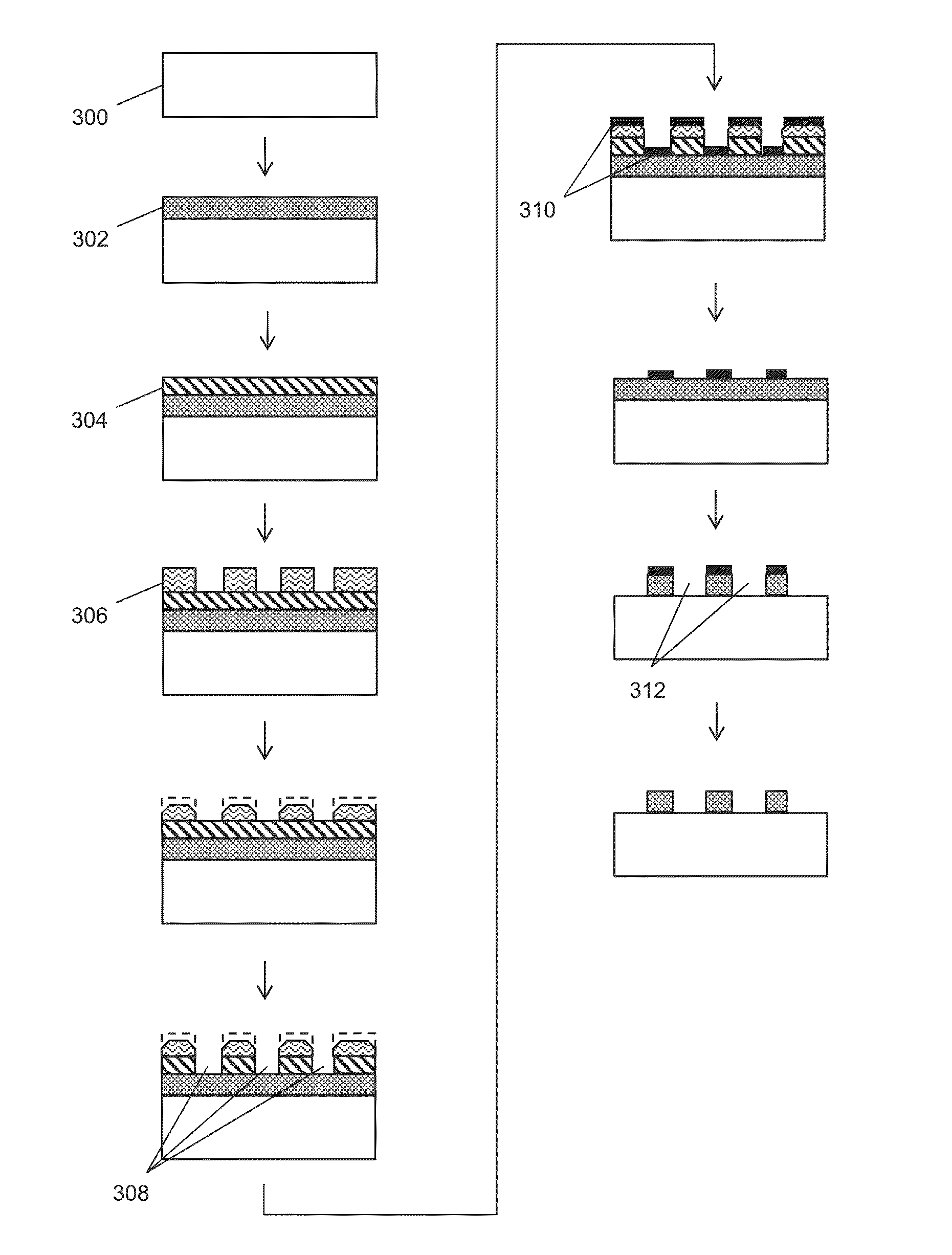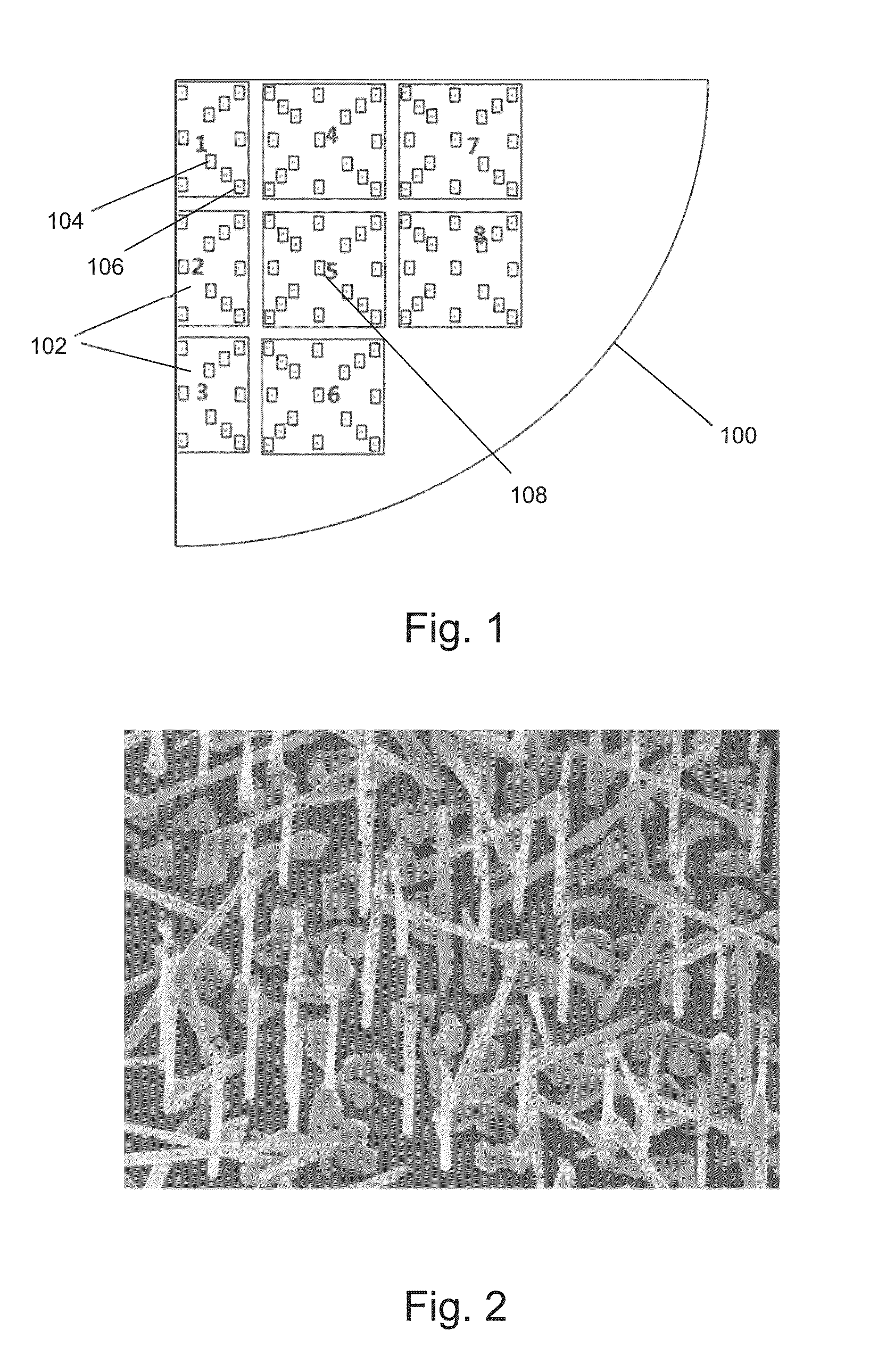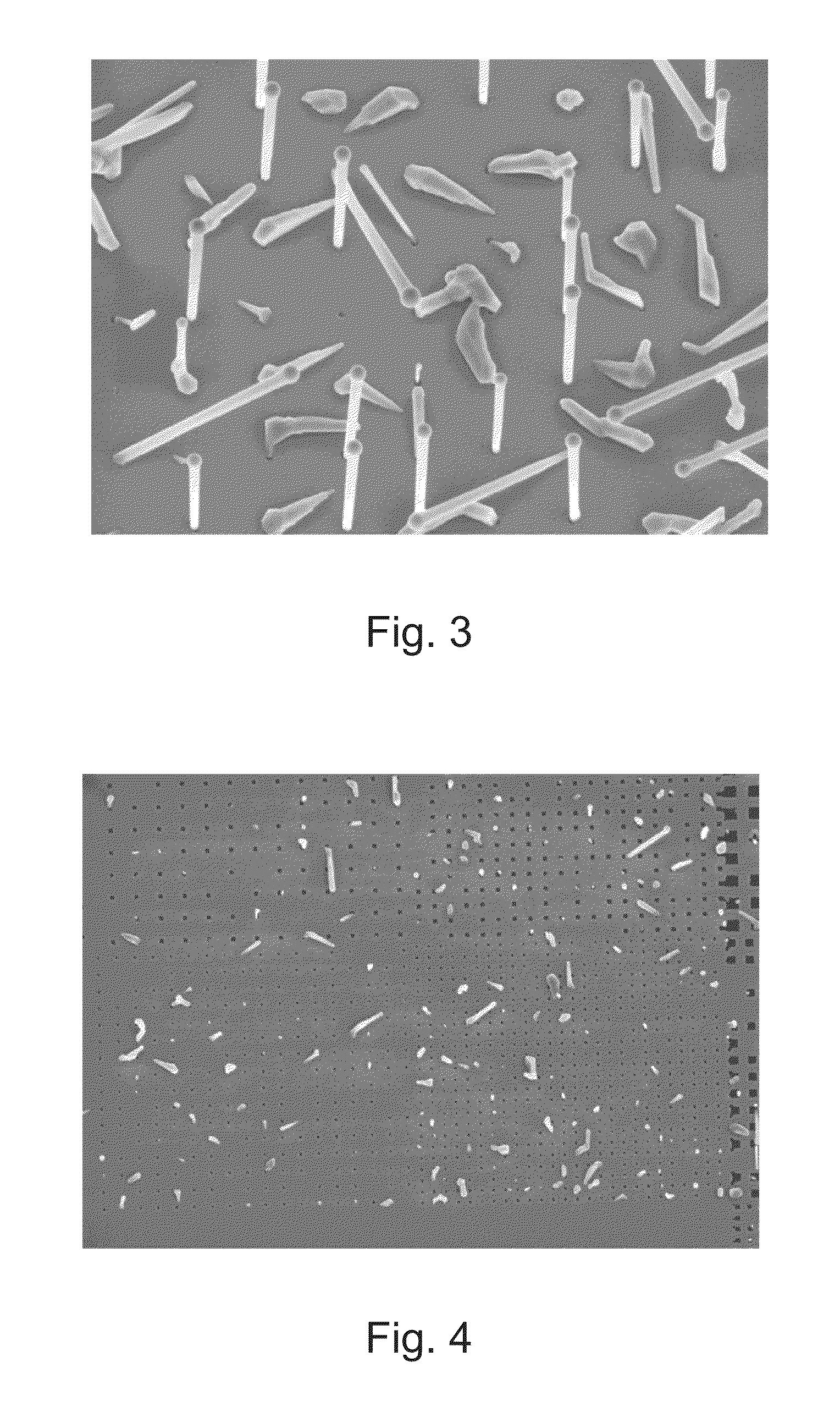Method of preparing a substrate for nanowire growth, and a method of fabricating an array of semiconductor nanostructures
a technology of nanowires and substrates, applied in the field of growth of semiconductor nanostructures, can solve the problems of difficult reproducibility of techniques and process that is actually non-positioned growth
- Summary
- Abstract
- Description
- Claims
- Application Information
AI Technical Summary
Benefits of technology
Problems solved by technology
Method used
Image
Examples
example 1
[0057]In example 1, growth of GaAsP nanowires on a patterned substrate was performed in an molecular beam epitaxy (MBE) apparatus in line with the stages set out in Table 2. Similarly to the comparative example above, the substrate was a quadrant of semiconductor wafer formed from p-type silicon., and the treatment surface was a (111) surface on which a layer of silicon dioxide having a array of holes fabricated therein was formed using the method described below with reference to FIG. 11. FIG. 5 shows a plan view of the substrate 200. FIGS. 6, 7 and 8 are SEM images taken at respective sub-regions 202, 204, 206 on the surface.
TABLE 2Growth parameters for example 1TimeTGa FluxV / IIIAs2 FluxP Flux(mins)(° C.)De-ox 1————5900De-ox 2————10880Warm-up——2.6 × 10−66.1 × 10−75Growth1.6 × 10−7202.6 × 10−66.1 × 10−740~6380.5 ml / sStop / cool0—0~0100
[0058]Example 1 thus differs from the comparative example due to the presence of a preliminary de-oxidation step in which the substrate is heated in th...
example 2
[0061]In example 2, growth of GaAsP core nanowires on a patterned substrate was performed in an molecular beam epitaxy (MBE) apparatus in line with the stages set out in Table 3. The process was set up in the same way as example 1.
TABLE 3Growth parameters for example 2TimeTGa FluxV / IIIAs4 FluxP Flux(mins)(° C.)De-ox————20832Ga deposit1.6 × 10−7———16000.5 ml / sGrowth 11.6 × 10−733.7 × 10−71.1 × 10−756000.5 ml / sGrowth 21.6 × 10−768.5 × 10−71.1 × 10−7106000.5 ml / s[in 30 s]Growth 31.6 × 10−7101.40 × 10−6 2.0 × 10−7106000.5 ml / s[in 30 s]Growth 41.6 × 10−7152.11 × 10−6 2.9 × 10−756000.5 ml / s[in 30 s][in 30 s]Growth 51.6 × 10−7202.82 × 10−6 3.8 × 10−7156000.5 ml / s[in 30 s][in 30 s]Stop / cool0—8.5 × 10−71.1 × 10−7100 [in 0 s] [in 0 s]
[0062]In this example, the preliminary de-oxidation process is a single stage, performed at a lower temperature but for a longer period than in example 1. FIG. 9 is an SEM image showing the results of this growth process. Again it may be seen that the nanowire gr...
example 3
[0063]In example 3, growth of core-shell nanowires on a patterned solar cell substrate was performed in an molecular beam epitaxy (MBE) apparatus in line with the stages set out in Table 4. The process was set up in the same way as example 1.
TABLE 4Growth parameters for example 3TimeTGa FluxIn FluxV / IIIAs4 FluxP Flux(mins)(° C.)DopingDe-ox—————20832—Ga deposit1.6 × 10−7————1600—0.5 ml / sGrowth 11.6 × 10−7—33.7 × 10−71.1 × 10−75600Be0.5 ml / s1.5 × 10−17Growth 21.6 × 10−7—68.5 × 10−71.1 × 10−710600Be0.5 ml / s[in 30 s]1.5 × 10−17Growth 31.6 × 10−7—101.40 × 10−6 2.0 × 10−710600Be0.5 ml / s[in 30 s]1.5 × 10−17Growth 41.6 × 10−7—152.11 × 10−6 2.9 × 10−75600Be0.5 ml / s[in 30 s][in 30 s]1.5 × 10−17Growth 51.6 × 10−7—202.82 × 10−6 3.8 × 10−715600Be0.5 ml / s[in 30 s][in 30 s]1.5 × 10−17Pause 10——2.82 × 10−6 3.8 × 10−710485—Pause 20——6.7 × 10−62.9 × 10−610485—Shell-p1.6 × 10−7—606.7 × 10−62.9 × 10−66485Be0.5 ml / s 5 × 10−16Shell-i1.6 × 10−7—606.7 × 10−62.9 × 10−620485—0.5 ml / sShell-n1.6 × 10−7—606.7 ...
PUM
| Property | Measurement | Unit |
|---|---|---|
| thickness | aaaaa | aaaaa |
| diameter | aaaaa | aaaaa |
| thickness | aaaaa | aaaaa |
Abstract
Description
Claims
Application Information
 Login to View More
Login to View More - R&D
- Intellectual Property
- Life Sciences
- Materials
- Tech Scout
- Unparalleled Data Quality
- Higher Quality Content
- 60% Fewer Hallucinations
Browse by: Latest US Patents, China's latest patents, Technical Efficacy Thesaurus, Application Domain, Technology Topic, Popular Technical Reports.
© 2025 PatSnap. All rights reserved.Legal|Privacy policy|Modern Slavery Act Transparency Statement|Sitemap|About US| Contact US: help@patsnap.com



